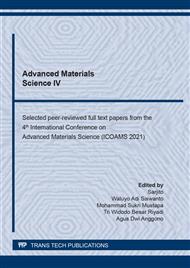p.89
p.95
p.102
p.111
p.119
p.125
p.131
p.137
p.147
Effect of Etching and Electroless Plating Time on Contact Angle of Acrylonitrile Butadiene Styrene for 3D-Printed Substrates
Abstract:
Acrylonitrile Butane Styrene (ABS) is a type of polymer that can be metallized with metal through the electroless plating process so as to produce a strong and economical layer bond compared to metal. In this study, ABS plastic will be coated with nickel and the contact angle of ABS after the coating process will be examined. The first step is the etching process for 55 and 75 minutes using chromic acid to improve the adhesiveness and uniformity of the coating metal later. After the etching process is complete, then the surface roughness test is carried out using Mitutoyo SJ 201 Surface Roughness. Furthermore, the activation process with stannous chloride as a catalyst is carried out to accelerate the deposition of metal particles on the substrate surface so that during the electroless plating process the polymer turns into a conductor. Then the electroless plating process with time variations of 15, 25, 35, 45, 55 minutes using nickel sulfate, ammonium chloride, sodium hypophosphite, and sodium hydroxide to deposit nickel metal on the ABS surface. The results of the coating are then analyzed for surface topography using AFM and SEM, as well as investigating the contact angle of the droplets that are dropped on the coated ABS surface. It can be said that the etching variation of 55 minutes electroless nickel plating 75 minutes is the most hydrophobic because it has the largest contact angle and the smoothest surface topography compared to other variations.
Info:
Periodical:
Pages:
119-124
Citation:
Online since:
January 2022
Keywords:
Price:
Сopyright:
© 2022 Trans Tech Publications Ltd. All Rights Reserved
Share:
Citation:


